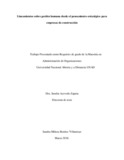Mostrar el registro sencillo del ítem
Lineamientos sobre gestión humana desde el pensamiento estratégico para empresas de construccción
| dc.contributor.advisor | Acevedo Zapata, Sandra | |
| dc.coverage.spatial | cead_-_josé_acevedo_y_gómez | spa |
| dc.creator | Benítez Villamizar, Sandra Milena | |
| dc.date.accessioned | 2018-10-24T23:09:34Z | |
| dc.date.available | 2018-10-24T23:09:34Z | |
| dc.date.created | 2018-03-30 | |
| dc.identifier.uri | https://repository.unad.edu.co/handle/10596/20919 | |
| dc.description.abstract | En el presente trabajo, se propuso desde el objetivo diseñar lineamientos sobre gestión humana para empresas de construcción desde el pensamiento estratégico, teniendo en cuenta el impacto que este proceso tiene para la permanencia y el crecimiento de las organizaciones del sector en mención en la ciudad de Bogotá. El análisis teórico se inicia con una revisión de artículos científicos para la construcción de los antecedentes y la contextualización del estado de la gestión humana en el sector empresarial colombiano, posteriormente, se procede a realizar un análisis metodológico, partiendo de una fase exploratoria en la que se estructura un modelo de análisis determinando las categorías que se van a analizar, de manera que se consiga el objetivo de identificar las necesidades en la gestión del talento humano de las empresas de construcción, esto mediante una observación participante y la recolección de datos sistemáticos y no intrusivos, en un diario de investigación reflexiva. Posteriormente, con el objetivo de recuperar la información se realiza la identificación de las características de la gestión humana en el sector de la construcción, por medio de entrevistas estructuradas a trabajadores o colaboradores del sector de la construcción de manera individual, posteriormente se clasifica la información para, en una última fase realizar el análisis con el objetivo de construir los lineamientos estratégicos. De la información obtenida por medio del diario de investigación reflexiva, se identifican preliminarmente consideraciones como la importancia, la sensación de seguridad y de estabilidad del trabajador y su influencia en la motivación laboral y la apropiación organizacional, el hombre como un recurso renovable e incluso descartable, la poca o nula existencia de manejo de gestión humana en las empresas de construcción y estas variables, como detonantes para continuos cambios de empleo. El análisis determina cómo la empresa del sector de la construcción aún maneja conceptos tradicionales que se relacionan con la cultura y el arraigo social y derivan en procesos desordenados y sin metodología con resultados poco eficientes para los colaboradores y la organización, sin embargo, también se percibe que hay un interés creciente en las organizaciones por el buen manejo de la gestión humana en niveles operativos, administrativos, gerenciales y de toma de decisión que permiten inferir que los lineamientos de gestión humana desde el pensamiento estratégico, impactarían positivamente en las estructuras organizacionales del sector. | spa |
| dc.format | spa | |
| dc.format.mimetype | application/pdf | spa |
| dc.language.iso | spa | spa |
| dc.publisher | Universidad Nacional Abierta y a Distancia UNAD | spa |
| dc.title | Lineamientos sobre gestión humana desde el pensamiento estratégico para empresas de construccción | spa |
| dc.type | Proyecto de investigación | spa |
| dc.subject.keywords | Empresa | spa |
| dc.subject.keywords | Socialismo | spa |
| dc.subject.keywords | Pensamiento | spa |
| dc.subject.keywords | Organización del trabajo | spa |
| dc.description.abstractenglish | In the present work, it proposed from the aim to design limits on human management for companies of construction from the strategic thought, bearing in mind the impact that this process has for the permanency and the growth of the organizations of the sector in mention in the city of Bogota. The theoretical analysis begins with a review of scientific articles for the construction of the precedents and the contextualization of the condition of the management humanizes in the managerial Colombian sector, later, one proceeds to realize a methodological analysis, departing from an exploratory phase in which a model of analysis is structured determining the categories that are going to be analyzed, so that there is obtained the aim to identify the needs in the management of the human talent of the companies of construction, this by means of an observation participant and the compilation of systematic and not intruder information, in a diary of reflexive investigation. Later, with the aim to recover the information there is realized the identification of the characteristics of the human management in the sector of the construction, by means of interviews structured to workers or collaborators of the sector of the construction of an individual way, later the information qualifies for, in a last phase to realize the analysis with the aim to construct the strategic limits. Of the information obtained by means of the diary of reflexive investigation, considerations are identified preliminary as the importance, the sensation of safety and of stability of the worker and his influence in the labor motivation and the appropriation organizational, the man as a renewable resource and enclosed disposable, small or void existence of managing management humanizes in the companies of construction and these variables, since explosive for continuous changes of employment. The analysis determines how the company of the sector of the construction still handles traditional concepts that relate to the culture and the social rooting and derive in messy processes and without methodology with slightly efficient results for the collaborators and the organization, nevertheless, also perceives that there is an increasing interest in the organizations for the good managing of the human management in operative, administrative, managerial levels and of capture of decision that they allow to infer that it humanizes the limits of management from the strategic thought, they would affect positively the organizational structures of the sector. | spa |
| dc.subject.category | Administración de Organizaciones | spa |
| dc.rights.accesRights | info:eu-repo/semantics/openAccess | spa |
| dc.rights.acceso | Abierto (Texto Completo) | spa |















